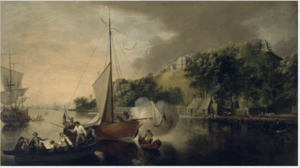Nathaniel Grogan facts for kids
Quick facts for kids
Nathaniel Grogan
|
|
|---|---|
| Born | circa 1740 Cork, Ireland
|
| Died | 1807 (aged 66–67) Cork
|
Nathaniel Grogan (1740–1807) was an important Irish painter from Cork. He is known for his unique paintings of everyday life in Ireland during the late 1700s. He was one of the most significant artists of his time in Ireland.
Life and Family
Nathaniel Grogan was born around 1740 in Cork, Ireland. He first worked as an apprentice for his father, who made things from wood. However, Nathaniel loved art and taught himself how to draw.
At first, he only had chalk and boards to draw on. Later, he trained with a local painter named John Butts in Cork. He was also inspired by Dutch painters like Hobbema. His father did not want him to be an artist, which led Nathaniel to leave home.
Once he became a successful artist in Cork, Grogan lived in a small house near the Mardyke. He passed away there in 1807. He is buried at the church of Saint Finnbarr. Grogan had 19 children, but only two sons survived: Nathaniel (who also became a painter) and Joseph. Both sons were known for painting copies of their father's artworks.
Career as an Artist
Nathaniel Grogan joined the British army and served in America. This was during the War of Independence. He also served in the West Indies. We do not know much about the paintings he made during this time. However, old advertisements show he offered "sign and ornamental painting."
After returning to Ireland, he painted decorations in houses. He decorated walls, doors, and ceilings for places like Mount Vernon. He created many oil and watercolour paintings. These showed landscapes and scenes of daily life in his home county of Cork. His painting Winter Scene with Skaters is considered one of his best.
Grogan is special because he painted "Irish peasant life." This was an unusual subject for Irish artists back then. His work shows the influence of Dutch paintings and English artists like George Morland. Grogan's paintings often had humor. They give us a rare look at how ordinary people lived during that time. Experts say his paintings are "the most important paintings of Irish peasant life of the period."
In 1782, he showed four landscape paintings in London. This was at the Free Society of Artists. He also spent some time in London. Grogan made some etchings, which are like prints. His most famous etchings were 12 views of Cork. He also made an engraving of Catherine Fitzgerald. The writer Maria Edgeworth mentioned Grogan's work in her letters. He was also popular with art collectors in Ireland.
Legacy and Recognition
In 1815, the Cork Society for Promoting the Fine Arts held its first exhibition. They displayed 25 paintings by Grogan. Later, in 1852, 18 of his works were shown at the Cork Exhibition. This included a painting he made of himself.
An art historian named Walter G. Strickland once said Grogan's art was "crude." He thought Grogan needed more training to be successful outside Cork. However, experts today have looked at his work again. They now see him as one of the most important Irish painters of the late 1700s.
A painting called View of Cork is in the Crawford Art Gallery. It was once thought to be by Grogan. Now, it is believed to be by his teacher, John Butts. Some paintings once thought to be by Nathaniel Grogan the elder are now believed to be by his son, Nathaniel. His son is considered a better painter of people.
Grogan's painting Whipping the Herring out of Town – A Scene of Cork was chosen as number 47 in a series called "Cork in 50 Artworks." This series was featured in the Irish Examiner newspaper.
Selected Works
- The Bantry Bard
- The Itinerant Preacher
- The Cronies
- The Wake
- The Quoit Players
- Irish Fair


